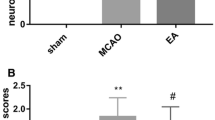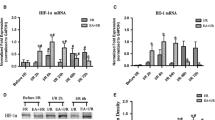Abstract
NLRP3/ASC/Caspase-1 mediated pyroptosis is one of the important causes of cerebral ischemia-reperfusion (I/R) injury. Electroacupuncture (EA) is widely used in clinical treatment of ischemic stroke. However, mechanism of EA on ischemic stroke remains unclear. Therefore, on basis of a previous work, this study used middle cerebral artery occlusion (MCAO) 2 h and then reperfusion 7 days in rats to simulate brain I/R process. EA with Bahui (GV20) and Zusanli (ST36) and VX-765 (a specific inhibitor of Caspase-1) was performed. In this study, we found that EA improved cerebral infarct size and neuronal damage, including ultrastructural injury, and ameliorated nitro/oxidative stress in cerebral I/R. Additionally, EA treatment significantly decreased ASC, Caspase-1, GSDMD, and IL-1β expression and VX-765 treatment significantly decreased NLRP3, Caspase-1, and IL-1β expression. This proved that EA can regulate NLRP3/ASC/Caspase-1 mediated pyroptosis, improve neuronal injury during cerebral I/R, and provide basic experimental data for clinical treatment.
Graphical Abstract





Similar content being viewed by others
Data Availability
Data and materials will be made available under reasonable request.
References
English C, MacDonald-Wicks L, Patterson A, Attia J, Hankey GJ (2021) The role of diet in secondary stroke prevention. Lancet Neurol 20:150–160
Brown DL, Levine DA, Albright K, Kapral MK, Leung LY, Reeves MJ, Sico J, Strong B et al (2021) Benefits and risks of dual versus single antiplatelet therapy for secondary stroke prevention: a systematic review for the 2021 Guideline for the Prevention of Stroke in Patients With Stroke and Transient Ischemic Attack. Stroke 52:e468–e479
Fusco R, Scuto M, Cordaro M, D'Amico R, Gugliandolo E, Siracusa R, Peritore AF, Crupi R et al (2019) N-Palmitoylethanolamide-oxazoline protects against middle cerebral artery occlusion injury in diabetic rats by regulating the SIRT1 Pathway. Int J Mol Sci 20(19):4845. https://doi.org/10.3390/ijms20194845
Catanese L, Tarsia J, Fisher M (2017) Acute ischemic stroke therapy overview. Circ Res 120:541–558
Zhang S, Wu B, Liu M, Li N, Zeng X, Liu H, Yang Q, Han Z et al (2015) Acupuncture efficacy on ischemic stroke recovery: multicenter randomized controlled trial in China. Stroke 46:1301–1306
Chi L, Du K, Liu D, Bo Y, Li W (2018) Electroacupuncture brain protection during ischemic stroke: a role for the parasympathetic nervous system. J Cereb Blood Flow Metab 38:479–491
Murray KN, Girard S, Holmes WM, Parkes LM, Williams SR, Parry-Jones AR, Allan SM (2014) Systemic inflammation impairs tissue reperfusion through endothelin-dependent mechanisms in cerebral ischemia. Stroke 45:3412–3419
Wang K, Ru J, Zhang H, Chen J, Lin X, Lin Z, Wen M, Huang L et al (2020) Melatonin enhances the therapeutic effect of plasma exosomes against cerebral ischemia-induced pyroptosis through the TLR4/NF-kappaB pathway. Front Neurosci 14:848
Gong Z, Pan J, Shen Q, Li M, Peng Y (2018) Mitochondrial dysfunction induces NLRP3 inflammasome activation during cerebral ischemia/reperfusion injury. J Neuroinflammation 15:242
He Q, Li Z, Meng C, Wu J, Zhao Y, Zhao J (2019) Parkin-dependent mitophagy is required for the inhibition of ATF4 on NLRP3 inflammasome activation in cerebral ischemia-reperfusion injury in rats. Cells 8(8):897. https://doi.org/10.3390/cells8080897
Xu H, Zhang Y, Sun H, Chen S, Wang F (2014) Effects of acupuncture at GV20 and ST36 on the expression of matrix metalloproteinase 2, aquaporin 4, and aquaporin 9 in rats subjected to cerebral ischemia/reperfusion injury. PLoS One 9:e97488
Xu H, Zhang YM, Sun H, Chen SH, Si YK (2017) Electroacupuncture at GV20 and ST36 exerts neuroprotective effects via the EPO-mediated JAK2/STAT3 pathway in cerebral ischemic rats. Evid Based Complement Alternat Med 2017:6027421
Ravizza T, Lucas SM, Balosso S, Bernardino L, Ku G, Noe F, Malva J, Randle JC et al (2006) Inactivation of caspase-1 in rodent brain: a novel anticonvulsive strategy. Epilepsia 47:1160–1168
Liang Y, Song P, Chen W, **e X, Luo R, Su J, Zhu Y, Xu J et al (2020) Inhibition of Caspase-1 ameliorates ischemia-associated blood-brain barrier dysfunction and integrity by suppressing pyroptosis activation. Front Cell Neurosci 14:540669
Lyu Z, Chan Y, Li Q, Zhang Q, Liu K, **ang J, Li X, Cai D et al (2021) Destructive effects of pyroptosis on homeostasis of neuron survival associated with the dysfunctional BBB-glymphatic system and amyloid-beta accumulation after cerebral ischemia/reperfusion in rats. Neural Plast 2021:4504363
Li W, Zou J, Shang J, Gao C, Sun R, Liu R, Cao H, Wang Y et al (2022) Both the complexity of tight junctions and endothelial transcytosis are increased during BBB postnatal development in rats. Front Neurosci 16:850857
Takata F, Nakagawa S, Matsumoto J, Dohgu S (2021) Blood-brain barrier dysfunction amplifies the development of neuroinflammation: understanding of cellular events in brain microvascular endothelial cells for prevention and treatment of BBB dysfunction. Front Cell Neurosci 15:661838
Qiu YM, Zhang CL, Chen AQ, Wang HL, Zhou YF, Li YN, Hu B (2021) Immune cells in the BBB disruption after acute ischemic stroke: targets for immune therapy? Front Immunol 12:678744
Yang Z, Lin P, Chen B, Zhang X, **ao W, Wu S, Huang C, Feng D et al (2021) Autophagy alleviates hypoxia-induced blood-brain barrier injury via regulation of CLDN5 (claudin 5). Autophagy 17:3048–3067
Yu P, Li Y, Zhong G, Li W, Chen B, Zhang J (2021) Claudin-5 affects endothelial autophagy in response to early hypoxia. Front Physiol 12:737474
Ren S, Han S, Wang L, Huang Y, Wu J, Wu G (2022) Minimally invasive surgery for ICH evacuation combined with deferoxamine treatment increased perihematomal Claudin-5 and ZO-1 expression levels and decreased BBB permeability in rabbits. Front Neurol 13:835494
Grochowski C, Litak J, Kamieniak P, Maciejewski R (2018) Oxidative stress in cerebral small vessel disease. Role of reactive species. Free Radic Res 52:1–13
Su XT, Wang L, Ma SM, Cao Y, Yang NN, Lin LL, Fisher M, Yang JW et al (2020) Mechanisms of acupuncture in the regulation of oxidative stress in treating ischemic stroke. Oxidative Med Cell Longev 2020:7875396
Zhang J, Dai Y, Yang Y, Xu J (2021) Calcitriol alleviates hyperosmotic stress-induced corneal epithelial cell damage via inhibiting the NLRP3-ASC-Caspase-1-GSDMD pyroptosis pathway in dry eye disease. J Inflamm Res 14:2955–2962
Zhang T, Du H, Feng S, Wu R, Chen T, Jiang J, Peng Y, Ye C et al (2019) NLRP3/ASC/Caspase-1 axis and serine protease activity are involved in neutrophil IL-1beta processing during Streptococcus pneumoniae infection. Biochem Biophys Res Commun 513:675–680
Zhang X, Liu Y, Deng G, Huang B, Kai G, Chen K, Li J (2021) A Purified biflavonoid extract From Selaginella moellendorffii alleviates gout arthritis via NLRP3/ASC/Caspase-1 axis suppression. Front Pharmacol 12:676297
He J, Zheng P, Chen Y, Qi J, Ye C, Li D, Yang Y, Yang Y et al (2022) A new personalized vaccine strategy based on inducing the pyroptosis of tumor cells in vivo by transgenic expression of a truncated GSDMD N-terminus. Front Immunol 13:991857
Hang Y, Tan L, Chen Q, Liu Q, ** Y (2021) E3 ubiquitin ligase TRIM24 deficiency promotes NLRP3/caspase-1/IL-1beta-mediated pyroptosis in endometriosis. Cell Biol Int 45:1561–1570
Shi J, Zhao Y, Wang K, Shi X, Wang Y, Huang H, Zhuang Y, Cai T et al (2015) Cleavage of GSDMD by inflammatory caspases determines pyroptotic cell death. Nature 526:660–665
Wang Y, Gao W, Shi X, Ding J, Liu W, He H, Wang K, Shao F (2017) Chemotherapy drugs induce pyroptosis through caspase-3 cleavage of a gasdermin. Nature 547:99–103
Liu S, Wang ZF, Su YS, Ray RS, **g XH, Wang YQ, Ma Q (2020) Somatotopic organization and intensity dependence in driving distinct NPY-expressing sympathetic pathways by electroacupuncture. Neuron 108:436–450.e7
Liu S, Wang Z, Su Y, Qi L, Yang W, Fu M, **g X, Wang Y et al (2021) A neuroanatomical basis for electroacupuncture to drive the vagal-adrenal axis. Nature 598:641–645
Acknowledgements
We thank the National Natural Science Foundation of China and the Natural Science Foundation of Shandong Province, China.
Funding
This work was supported by the National Natural Science Foundation of China (No. 82205250) and the Natural Science Foundation of Shandong Province, China (No. ZR2021QH056), to Dr. Huanyuan Wang. All funding bodies funded in study design, collection, analysis, interpretation of data, and writing manuscript.
Author information
Authors and Affiliations
Contributions
The study concept and design: Huanyuan Wang, Bin Tang, and Yan Li. Writing of the manuscript: Huanyuan Wang. Data analysis: Huanyuan Wang and **fa Xu. Obtaining data: Huanyuan Wang, Bin Tang, Yan Li. Interpretation of results: Huanyuan Wang and Guangzhong Du. Critical revisions of the manuscript: Huanyuan Wang. Approval of the version for submission: All the authors.
Corresponding author
Ethics declarations
Ethics Approval
All applicable international, national, and/or institutional guidelines for the care and use of animals were followed. This study was performed under supervision of the Animal Care and Use Committee of Qilu Hospital of Shandong University. All procedures performed in studies involving animals were by the ethical standards of the institution or practice at which the studies were conducted by Experimental Animal Center of Shandong University.
Consent to Participate
Not applicable
Consent for Publication
All co-authors approved final version of manuscript and agreed to submit it to Molecular Neurobiology.
Conflict of Interest
The authors declare no competing interests.
Additional information
Publisher’s Note
Springer Nature remains neutral with regard to jurisdictional claims in published maps and institutional affiliations.
Rights and permissions
Springer Nature or its licensor (e.g. a society or other partner) holds exclusive rights to this article under a publishing agreement with the author(s) or other rightsholder(s); author self-archiving of the accepted manuscript version of this article is solely governed by the terms of such publishing agreement and applicable law.
About this article
Cite this article
Tang, B., Li, Y., Xu, X. et al. Electroacupuncture Ameliorates Neuronal Injury by NLRP3/ASC/Caspase-1 Mediated Pyroptosis in Cerebral Ischemia-Reperfusion. Mol Neurobiol 61, 2357–2366 (2024). https://doi.org/10.1007/s12035-023-03712-1
Received:
Accepted:
Published:
Issue Date:
DOI: https://doi.org/10.1007/s12035-023-03712-1




